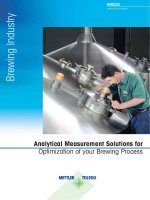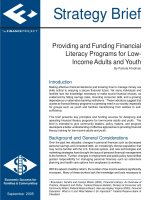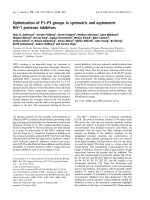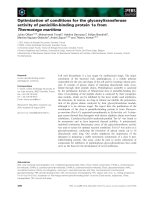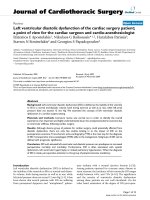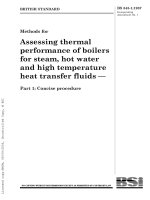Multi-responses Optimization of Dry Milling of SKD61 for Low Machining Power and Surface Roughness
Bạn đang xem bản rút gọn của tài liệu. Xem và tải ngay bản đầy đủ của tài liệu tại đây (744.54 KB, 13 trang )
<span class='text_page_counter'>(1)</span><div class='page_container' data-page=1>
<b>Multi-responses Optimization of Dry Milling of SKD61</b>
<b>for Low Machining Power and Surface Roughness</b>
Nguyễn Trung Thành1*<sub>, Nguyễn Tuấn-Nhật</sub>2
1 <sub>Military Technical Academy, 236 Hoang Quoc Viet, Hanoi, Viet Nam</sub>
2<sub>25 Mechanical Company, Soc Son District, Ha Noi, Viet Nam</sub>
Email:, Tel: +84-69-515-368
<b>ABSTRACT</b>
Optimized process parameters play a significant role in improving the energy
efficiency and machined part quality. This paper systematically investigates the
nonlinear relationships between machining parameters and responses, including
<i>machining power Pc and surface roughness Ra of the dry milling (DM) using the</i>
response surface model (RSM). Three process parameters considered include the
<i>spindle speed S, depth of cut ap, and feed rate fz</i>. A set of physical experiments was
carried out with SKD61 steel on a CNC milling machine using the wiper insert.
The target of the current complex optimization is to find the low machining power
and surface roughness. Finally, an evolutionary algorithm entitled non-dominated
sorting genetic algorithm II (NSGA-II) was used to generate a set of feasible
optimal solutions and determine the best machining conditions. The results show
that an appropriate trade-off solution can be drawn with regard to the low cutting
power and surface roughness. Furthermore, the integration of RSM model and
NSGA-II can be considered as a powerful approach for modeling and optimizing
dry milling processes.
<b>KEYWORDS: Machining power, Surface roughness, Dry milling, Modeling,</b>
Pareto.
<b>I. INTRODUCTION</b>
</div>
<span class='text_page_counter'>(2)</span><div class='page_container' data-page=2>
factories. Additionally, the energy efficiency of machining process is less than
30% [2]. The energy efficiency of a case study described by Gutowski is only 14.8
% [3]. As a result, it has great potential for energy savings in machining processes.
Therefore, reducing energy consumed in machining operations is a significant
contribution to improving the energy efficiency in manufacturing
Energy saving technologies for cutting process can be divided into two
solutions. The first solution mainly focuses on machine design and improvement as
well as new cutting technologies used. The second solution pays attention to
investigate the relationship among cutting conditions and energy consumption and
leads to the development of energy consumption models and optimal parameters in
terms of energy savings. Design methodologies [4] and the intelligent control [5]
were proposed to improve the energy efficiency of cutting process. Additionally,
devices consumed less energy also were used to improve the energy efficiency [6].
Apparently, the first branch based on hardware technologies is too costly to renew
or replace existing devices. Improving the energy efficiency should be made firstly
in existing machines and the second solution is an intelligent choice. The
optimizing cutting process is less expensive and has better social sustainability
compared to making drastic changes due to the low investment needed and user
acceptance [7]. Consequently, optimal cutting conditions selection plays an
important role in reducing energy consumption in cutting process.
</div>
<span class='text_page_counter'>(3)</span><div class='page_container' data-page=3>
Fig. 1 Optimizing procedure for machining power and surface roughness
<b> Table 1. Machining parameters and their values </b>
Symbo
l
Parameters
level-1
level
0
level
+1
<i>S</i> Spindle speed (rpm) 1000 2000 3000
<i>ap</i> Depth of cut
(mm/min)
0.02 0.06 0.1
<i>fZ</i> Feed per teeth (mm/z) 0.04 0.1 0.16
<b>II. MATERIALS AND METHODS</b>
The systematic research procedure for experimental conductions and
parameter optimization is depicted in Fig. 1. The Box-Behnken method was
applied instead of the full-factorial in order to decrease the number of experiments
and guarantee the predicting accuracy [8, 9]. Three machining parameters,
<i>including the spindle speed S, depth of cut ap, and feed rate fz</i> with their levels were
</div>
<span class='text_page_counter'>(4)</span><div class='page_container' data-page=4>
values and improving one objective is impossible without sacrificing one or more
of the other objectives.
(a) CNC machine and workpiece (b) Control unit and PC
z
(c) Surface roughness measurement
Fig. 2 Experimental facilities
</div>
<span class='text_page_counter'>(5)</span><div class='page_container' data-page=5>
2 2 2
( )
60000 60000
<i>x</i> <i>y</i> <i>z</i> <i>c</i>
<i>c c</i>
<i>c</i>
<i>F</i> <i>F</i> <i>F V</i>
<i>F V</i>
<i>P</i> <i>kW</i> (1)
<i>where Pc is the machining power (kW). Vc is the cutting speed (m/min). Fx, Fy, and</i>
<i>F</i>z are the cutting forces in x, y, and z direction, respectively.
The surface roughness values were measured by a tester Mitutoyo SJ-301.
The average response values were observed from repeated three times at different
positions (Fig. 2c).
Table 2 Experimental results
No. <i>S (rpm)</i> <i>a</i>p (mm) <i>f</i>z (mm/tooth) <i>P</i>c (kW) <i>R</i>a (µm)
1 4000 1.0 0.10 1.0695 0.94
2 3000 0.6 0.10 0.7243 0.71
3 3000 0.6 0.10 0.7319 0.73
4 3000 0.6 0.10 0.7206 0.73
5 3000 0.2 0.16 0.6196 1.13
6 4000 0.6 0.04 0.5811 0.51
7 3000 1.0 0.04 0.5848 0.93
8 3000 0.6 0.10 0.7300 0.73
9 3000 0.6 0.10 0.7187 0.73
10 3000 1.0 0.16 0.9801 1.51
11 2000 0.2 0.10 0.4752 0.73
12 2000 1.0 0.10 0.6897 1.13
13 2000 0.6 0.04 0.4554 0.7
14 4000 0.2 0.10 0.6116 0.52
15 2000 0.6 0.16 0.6724 1.29
16 3000 0.2 0.04 0.4055 0.53
17 4000 0.6 0.16 0.9947 0.99
<b>III. EXPERIMENTAL RESULTS </b>
In this paper, the significance of the models proposed and factors considered
are evaluated using an analysis of variance (ANOVA). The confidence level of
95% was used and the factors with p-values less than 0.05 are considered as
significant. The experimental results of the dry milling are given in Table 2.
ANOVA results of the objective functions are presented in Table 3 and 4
respectively.
<i>As shown in Table 3, the R2</i><sub> value of 0.9945 revealed that machining power</sub>
</div>
<span class='text_page_counter'>(6)</span><div class='page_container' data-page=6>
<i>result, the S, ap, fz, Sap, Sf</i>z, <i>a</i>p<i>f</i>z and fz^2 are significant terms. The percentage
<i>contribution of 35.57% revealed that fz is the most effective factor with regard to</i>
<i>the single term. The percentages of S and ap are 21.52% and 33.99%, respectively.</i>
<i>The insignificant terms (S</i>^2<i><sub>, ap</sub></i>^2<sub>) were eliminated in the design space in order to</sub>
save the computational costs and time.
Table 3 ANOVA results for machining power
Sourc
e
Sum of
Squares
Mean
Square
F-value p-value Remark Contri.
(%)
Model 0.540732 0.060081
141.796
5
<
0.0001 Significant
<i>S</i> 0.116215 0.116215
274.275
4
<
0.0001
Significant
21.51
<i>a</i>p 0.18368 0.18368
433.497
6
<
0.0001
Significant
33.99
<i>f</i>z 0.192207 0.192207
453.623
7
<
0.0001 Significant 35.57
<i>Sa</i>p 0.014812 0.014812
34.9584
9 0.0006 Significant 2.74
<i>Sf</i>z 0.009658 0.009658
22.7938
8 0.0020 Significant 1.79
<i>a</i>p<i>f</i>z 0.008215 0.008215
19.3891
3 0.0031 Significant 1.52
<i>S</i>^2 <sub>0.000231 0.000231</sub> 0.54430<sub>3</sub> <sub>0.4846</sub> Insignifican<sub>t</sub> <sub>0.04</sub>
<i>a</i>p^2 0.001851 0.001851
4.36801
6 0.0750 Insignifican 0.34
<i>f</i>z^2 0.013483 0.013483 31.822 0.0008 Significant 2.50
<i>R</i>2<sub> = 0.9945</sub>
Table 4 ANOVA results for surface roughness
Sourc
e
Sum of
Squares
Mean
Square
F-value p-value Remark Contri.
(%)
Model 1.258329 0.139814 392.2645 < 0.0001 Significant
<i>S</i> 0.103513 0.103513 290.4158 < 0.0001 Significant 8.28
<i>a</i>p 0.316013 0.316013 886.6082 < 0.0001 Significant 25.28
</div>
<span class='text_page_counter'>(7)</span><div class='page_container' data-page=7>
<i>Sa</i>p 0 0 0 1.0000 Insignificant 0.00
<i>Sf</i>z 0.003025 0.003025 8.486974 0.0226 Significant 0.24
<i>a</i>p<i>f</i>z 2.5E-05 2.5E-05 0.07014 0.7988 Insignificant 0.00
<i>S</i>^2 <sub>0.002527 0.002527 7.090813</sub> <sub>0.0323</sub> <sub>Significant</sub> <sub>0.20</sub>
<i>a</i>p^2 0.071706 0.071706 201.18 < 0.0001 Significant 5.74
<i>f</i>z^2 0.126017 0.126017 353.5543 < 0.0001 Significant 10.08
<i>R</i>2<sub> = 0.9980</sub>
The ANOVA results of the surface roughness model are presented in Table
<i>4. The R2</i><sub> value of 0.9980 indicated that proposed model was significantly adequate</sub>
to represent the experimental data. The surface roughness model is significant due
<i>to the p-value of less than 0.0001. For this model, the single terms (S, ap, f</i>z),
<i>quadratic terms (S2<sub>, a</sub></i>
p^2<i>, f</i>z^2<i>), and the interaction term (Sfz) were considered as the</i>
<i>significant terms. The interaction terms (Sap, apf</i>z) were found to be insignificant
<i>model terms. Especially, fz is the most effective parameter due to the highest</i>
<i>contribution (50.17%). The percentages of S and ap are 25.28% and 8.28%,</i>
<i>respectively. Additional, the percentages of fz</i>^2<i><sub>, ap</sub></i>^2<i><sub>, and S</sub></i>2 <sub>were 10.08%, 5.74%,</sub>
and 0.20%, respectively.
To confirm the analyzed results, the Pareto charts of all terms were
generated based on the F-values. The aim of the Pareto charts is to rank in
descending order the effects of the burnishing parameters and their interactions on
<i>the technological outputs. The Pareto charts of Pc and Ra were shown in Fig. 3a</i>
and b, respectively. It can be stated that the Pareto charts are similar to the
ANOVA results.
</div>
<span class='text_page_counter'>(8)</span><div class='page_container' data-page=8>
(b) For surface roughness
Fig. 3 Pareto chart
The response models (machining power, surface roughness) were developed
in terms of input parameters using response surface methodology. From the
experimental data, the coefficients of the regression equations are calculated. The
regression coefficients of insignificant terms were eliminated based on ANOVA
results. Consequently, the regression response surface models showing the
<i>machining power (Pc) and surface roughness (Ra) are expressed as follows:</i>
<i>P</i>c = 0.37294-0.000097S-0.10917ap+2.13734fz+0.000152Sap+0.000819Sfz
<i>+1.88832apf</i>z-0.13104ap2-15.71919fz2
(2)
<i>R</i><sub></sub>
<i>a=0.71039+0.000079S-0.47146ap-3.50694fz-0.000000025S2+0.81563ap</i>2
<i>+48.05556fz</i>2
(3)
</div>
<span class='text_page_counter'>(9)</span><div class='page_container' data-page=9>
<i><b>(c) R</b></i><b>a</b><i><b> versus S and a</b></i><b>p</b> <i><b>(d) R</b></i><b>a</b><i><b> versus f</b><b>z</b><b> and a</b></i><b>p</b>
</div>
<span class='text_page_counter'>(10)</span><div class='page_container' data-page=10>
The effects of process parameters on the responses were investigated using
the contour plots. Figs. 4a and b showed that an increase of the spindle speed,
depth of cut, and feed rate results in a higher machining power. This phenomenon
<i>can be explained as follows. Increasing ap or fz increased the material removal</i>
volume in the same unit of time, thus resulting in a higher cutting force or power
consumed. An improved spindle speed causes an increased cutting speed and a
higher machining power is observed.
Fig. 4c and d exhibited that the surface roughness was also decreased with an
<i>increment of S. A reduction of cutting force can be observed at the higher spindle</i>
speed, resulting in a smoother surface. An increased cutting force or machining
power caused by a higher depth cut or feed rate results in a coarser surface
roughness.
<b>IV. OPTIMIZATION RESULTS</b>
<i>As a result, the inputs, including S, ap, and fz have complicated effects on the</i>
technological parameters, including machining power and surface roughness. The
optimizing issue can be described as follows:
<i>Find X = [S, ap, fz]</i>
<i>Minimize machining power Pc and surface roughness (Ra) </i>
Constraints:
<i>2000 ≤ S ≤ 4000 (rpm), 0.2 ≤ ap ≤ 0.4 (mm), 0.04 ≤ fz ≤ 0.16 (mm).</i>
</div>
<span class='text_page_counter'>(11)</span><div class='page_container' data-page=11>
Table 5 Optimal values of process parameters and responses
<i>S (rpm)</i> <i>a</i>p (mm) <i>f</i>z (mm/tooth) <i>P</i>c (kW) <i>R</i>a (µm)
3996 0.2 0.04 0.40 0.43
Fig. 5 Pareto front for selecting optimal values
<b>CONCLUSIONS</b>
This work addressed the process parameters optimization of the dry milling
for low machining power as well as surface roughness. A hybrid approach
combining machining experiments, RSM model, and NSGA-II was proposed in
order to develop predictive models and determine the optimal values. An ANOVA
analysis was performed to evaluate the model adequacy and factor significance.
The main conclusions from the research results of this work can be drawn as
follows within parameter ranges:
1. The low process parameters were commented to decrease the machining
power, in which depth of cut and feed rate have the higher contribution, compared
to the spindle speed.
</div>
<span class='text_page_counter'>(12)</span><div class='page_container' data-page=12>
3. The optimizing issue, in which the machining power and surface roughness
is practical and realistic in the dry milling processes, compared to single objective
optimization (i.e. Minimizing surface roughness).
This work is expected as a significant contribution to improve the dry milling
efficiency (i.e. Low energy consumed and surface roughness). The holistic
optimization considering more objectives, such as material removal rate and tool
wear will be addressed in the future work.
<b>ACKNOWLEDGMENT</b>
This research is funded by Vietnam National Foundation for Science and
Technology Development (NAFOSTED) under grant number 107.04-2017.06
<b>REFERENCES</b>
[1] Viet Nam Ennergy Sector, Assessment, Strategy, and road map,
2015.
[2] S.H. Hu, Energy consumption characteristics of multiple-component of modern
cnc machine tools, Chongqing University, 2012.
[3] Gutowski T.G., Branham M.S., Dahmus J.B., Jones A.J., Thiriez A., Sekulic
D.P., Thermodynamic analysis of resources used in manufacturing processes,
Environmental Science and Technology 43 (2009).
[4] ISO/TC 39/SC, Machine tools-environmental evaluation of machine tools-part
1: design methodology for energy-efficient machine tools, Draft International
Standard ISO/DIS 14955-1, 2012.
[5] />
[6] Zhongde, S., Shaoyan, Q., Qian, L., Feng, L., Key manufacturing technology &
equipment for energy saving and emissions reduction in mechanical equipment
industry, International Journal of Precision Engineering and Manufacturing 13
(2012).
[7] Pusavec, F., Krajnik, P., Kopac, J., Transitioning to sustainable production-part
<b>I: application on machining technologies, </b>Journal of Cleaner Production 18(2010).
[8] C.F. Jeff, R. C. Z., Y. Lan, Experiment Design & Analyses and Parameters
Optimization, Wiley, 2009.
</div>
<span class='text_page_counter'>(13)</span><div class='page_container' data-page=13>
Precision Engineering and Manufacturing 17 (2016).
[10] H. S. Park; T. T. Nguyen, Development of a new staking process for an
automotive part, The International Journal of Advanced Manufacturing
Technology 89 (2017).
[11] H. S. Park, T. T. Nguyen, Optimization of injection molding process for car
fender in consideration of energy efficiency and product quality, Journal of
</div>
<!--links-->
<a href=' /> BT 3 optimization of medium for indole 3 acetic acid production using pantoea agglomerans strain PVM
- 10
- 544
- 1

